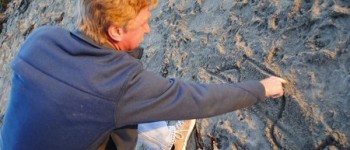This story was published on Dec. 3, 2010 on Half Moon Bay Patch. It won a second-place prize in the San Francisco Peninsula Press Club’s 2011 Greater Bay Area Journalism Awards competition for the “Sports Story” category in the Broadband/Web division.
 To a nonsurfer, it may seem like a formidable task and a lot of pressure—forecasting big waves for The Jay At Mavericks Big Wave Invitational, one of the top surfing competitions in the world. But to Mark Sponsler, official surf forecaster for the contest, it’s a fairly simple task that can be boiled down to a basic science.
To a nonsurfer, it may seem like a formidable task and a lot of pressure—forecasting big waves for The Jay At Mavericks Big Wave Invitational, one of the top surfing competitions in the world. But to Mark Sponsler, official surf forecaster for the contest, it’s a fairly simple task that can be boiled down to a basic science.
Instead of being held on a set date, the competition has a three-month contest window from Dec. 1 to Feb. 28, meaning that the event can take place at any time during this period. The window ensures that the surf conditions on the day of the event are befitting of The Jay At Mavericks’ prestigious nature. Invited competitors are essentially on call to arrive in Half Moon Bay. In previous years, competitors had only 24 hours to arrive after the call was made for the competition to begin.
Sponsler, an unassuming man who is quick to smile and laugh—and is also a surfer himself—runs stormsurf.com, a global surf forecasting site. He is not a formally trained meteorologist, but is self-taught. Though he is the one to notify contest organizers when he thinks it’s the right time to hold the contest, Sponsler says that the process is more collaborative than his title betrays.
“By looking at the surf report, the surfers already know pretty much when the competition will be held,” he said this past Monday, standing on the beach at Mavericks as he looked out to the ocean where surfers were engaging in the traditional prayer circle as part of the day’s opening ceremonies.
When the data looks right, Sponsler talks with the organizers, and more in-depth analysis of the conditions take place.
“When we think it’s time, they [the competitors] talk about if they think the conditions are right, and if they agree, then the call is made,” Sponsler says.
Though Sponsler is on call for what could potentially be almost three months, he doesn’t appear to be burdened at all by the assignment—nor does he let his added responsibilities hinder his regular activities during the period—responsibilities that include a day job.
“I can do it all by digital device,” he said. “I check the data about three or four times daily—I can even be skiing at the top of a mountain and look at it,” he said. The first time he looks at the surf conditions data each day, he says, is at 6:30 a.m.
Sponsler got started in surf forecasting by building the analytical models that he uses to predict surf conditions. As a software project manager by trade, he drew upon his programming experience to capitalize on data collected from buoys essential in forecasting surf conditions that are stationed around the world by the U.S. National Oceanic and Atmospheric Administration (NOAA) and other countries.
Equipped with digital Iridium Satellite sensors, the buoys’ sensors measure wave height, wave period, wind speed, and barometer pressure, according to Sponsler. The buoys relay this data by satellite to NOAA’s headquarters, which then makes its way to Sponsler’s computer, thanks to a Freedom of Information Act request Sponsler filed to get access to the data.
“Because the buoys are off the coast, you can really see the swell coming,” Sponsler says.
Sponsler’s computer is able to render the data live, he says, and the data gets fed into algorithms and surf forecast models he developed. The models update three or four times a day, which is when Sponsler checks the data during the contest window period. In addition to Mavericks’ swells, Sponsler’s website shows data from around the world, and provides a tutorial section so that anyone interested in learning how to read the data can do so.
What kind of surf conditions is Sponsler looking for? Buoys reading a “pure swell of 10 feet with wave crests of 18 seconds apart,” he says. “The wind has to be just right when the swell arrives also, along with having low tide and sunlight.”
Though the word around Monday’s opening ceremonies was that no big wave action would be happening at Mavericks in the first part of this month, Sponsler seemed as positive as ever for the opening of the contest window to begin.
Ironically, Sponsler’s surf-forecasting career got started at the time when he had to move away from Mavericks—all the way to the East Bay, where he lives now in Castro Valley. “I couldn’t just check the conditions out here anymore,” he said.
Though Sponsler can’t be out surfing as much as he did before, the big wave competition at Mavericks is all the better for it.
Photo by Kristine A. Wong